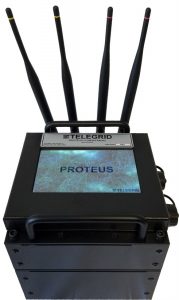TELEGRID wireless mesh networks provide customers with a full range of products in this growing technology space.
Network security is the number ONE concern in all networks developed by TELEGRID.
AeroGRID+ – Drone Swarm Technology
AeroGrid+ is a drone swarm technology that facilitates the formation of an interconnected swarm of drones that operate autonomously by sharing situational awareness and operational information.
AeroGrid+ is drone-agnostic and can be used with most drones. It is driven by a software application which can be changed in order to change the functionality of specific drones in the swarm.
AeroGRID+ is a companion processor with an integrated MIMO mesh radio and interfaces to the drone’s flight controller. It allows drones to interoperate with other drones and with ground stations via a secure wireless broadband mesh network and exchange both mission data (i.e., streaming video) and telemetry.
AeroGRID+ processes all received mission data and telemetry and derives a full situational awareness picture which it shares with other drones and ground stations. This allows each drone to operate autonomously. For example, drones can change their location, position, and operating parameters in order to optimize sensors’ performance, improve network quality, increase range and air-time, etc. The result is a fluid topology, where drones continuously move while inter-communicating. This facilitates advanced functions which are not possible with drones that just hover in a fixed location.
AeroGRID+ combines a universal hardware platform and a suite of software applications developed by TELEGRID or by third party developers. These apps incorporate Artificial Intelligence (AI) and Machine Learning (ML) technologies making AeroGRID+ a powerful force multiplier in military and commercial applications.
To learn more click here or view the DATA SHEET
Proteus – Ground Sensor System

The TELEGRID Proteus Wireless Mesh Network is a flexible, ad-hoc, self-forming wireless network based on the 802.11/b/g/n IEEE standard. It is composed of a collection of stationary, mobile, or airborne nodes formed by TELEGRID Proteus Radios that operate in the 900 MHz, 2.4 GHz and 5.8 GHz frequency bands. Ad-hoc networks operate without a centralized access point or existing infrastructure and are self-forming and self-healing. They can be deployed in stationary architectures, such as with unattended ground sensors, or in mobile or airborne applications where network topology is unpredictable.
The main element of the Proteus Wireless Mesh Network is the Proteus Radio which is a modular radio that can be configures by the network architect to satisfy specific requirements. The radio is composed of the following four basic modules:
- Dual Radio Module(2×2 MIMO)
- Power Supply/ Battery Module
- Sensors Interface Module
- Touch-Screen Display Module
Options available for the Dual Radio Module include:
- Two 2.4GHz Radios
- Two 5.8GHz. Radios
- One 2.4GHz/ 5.8GHz Radio and One 900MHz Radio
Options for the power supply module include AC power, DC power, rechargeable battery power or solar panel power.
The Proteus Radio design uses TELEGRID’s award winning Embedded Security Framework (ESF) which is a collection of DISA STIG/ SRG compliant encryption and authentication modules. Combining the ESF with a LINUX OS Container means sensor network integrators no longer have to worry about integrating security at the edge. The ESF handles all encryption and authentication including FIPS 140-2 compliance. Data Sheet
For a white paper on the how the Proteus network works Click Here
